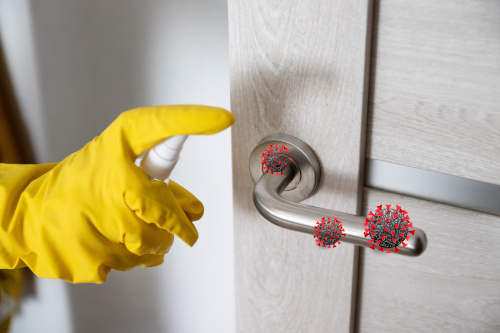As students, faculty, and staff returned to school this fall, there was a new emphasis on the importance of cleaning and disinfecting surfaces to prevent the spread of the COVID-19 virus.
Along with maintaining social distance, wearing masks, and regular hand washing, schools are also cleaning and disinfecting furniture pieces and work surfaces to promote healthy and functional learning spaces.
Thorough cleaning and disinfection of work surfaces, school furniture and other high-touch areas can help reduce the spread of COVID-19 in schools and communities.
With this in mind, it’s important to consider how your school’s work surfaces and furniture materials will react to these increased cleaning measures—both in terms of successful disinfection and durability after repeated exposure to cleaning products.
Here are three easy-to-clean surfaces to incorporate into your learning spaces:
1. Laminate. Surfaces that are designed for safety, efficiency, and learner comfort play a key role in creating a positive tone within learning environments, laminate work surfaces are simple to clean and disinfect due to their non-porous surfaces, resistance to scratches and cracks, and absence of surface texture. Laminate surfaces are also durable and easy to manage during regular periods of cleaning and disinfection.
The mission of every school community is to provide safe learner centered physical spaces, so it provides a wide range of laminate surfaces that address disinfection, durability and design. Because laminate is a completely sealed surface, disinfection is also quick and effective, and can be done with a variety of EPA-registered disinfectants without degradation of the surface. The recommended cleaners include (but aren’t limited to): Windex®, Glass Plus®, Fantastik®, isopropyl alcohol and bleach-free wipes. To ensure durability after repeated disinfection and learn how to responsibly care for your furniture, refer to Formica’s laminate cleaning and disinfection guide or Panolam’s care and maintenance recommendations.
2. Vinyl. Vinyl surfaces are particularly easy to clean due to their non-porous surfaces and minimal texturing. A simple soap and water solution or other basic cleanser does a sufficient job at removing surface dirt and germs. Disinfection of vinyl should be done by following the directions of a compatible disinfectant. As long as the right products and methods are used, the vinyl material won’t degrade with repeated disinfection. Stinson offers a disinfectant and cleaner compatibility tool in its online fabric browsing catalog, ensuring the compatibility of your school’s commonly used cleaning products with different vinyl and non-PVC materials.
3. Performance fabrics. With soft seating becoming more prevalent in school design, the upholstery materials preferred for school furniture applications have certain characteristics in common. They’re not only available in a broad palette of colors and offer a soft feel for comfort and warmth, but the materials must also meet a high bar for performance and durability. Many are bleach-solution cleanable without staining or fading of the material. Fabrics must have the capability to withstand the required protocols of good environmental cleaning and disinfection practices in the educational setting. Anti-bacterial and anti-fungal Crypton® and vinyl textiles are inherently resistant to bacterial growth because they are:
- Impermeable to moisture and provides a fluid barrier for the furniture’s inner cushion
- Wear resistant and avoids the degradation of scuffs, scratches, and cracking
- Minimally textured, if at all, promoting ease of cleaning and disinfection
- Stain resistant and highly cleanable without aggressive scrubbing
Combined, these attributes can simplify cleaning and disinfecting methods for school facilities. Stinson Fabrics’ online search tool shows compatibility with EPA-Registered disinfectants for use against COVID-19, making it easy to specify fabric solutions. Gabriel has developed a fabric cleaning and viral and bacterial protection guide to help schools maintain their soft seating and upholstered furniture pieces.
With COVID-19 health and safety procedures expected to stay in place for a while, the furniture you choose for your learning spaces must be constructed with the right fabrics and finishes to withstand repetitive cleaning and disinfection.
Not only are surface materials like vinyl, laminate and performance fabrics known for their ease of maintenance and cleaning, but they also provide high levels of strength and durability, even with consistent use.
- 4 ways to encourage play in education - April 25, 2024
- CoSN IT Leader Spotlight: Lisa Higgins - April 25, 2024
- It’s time to pay student teachers - April 25, 2024

